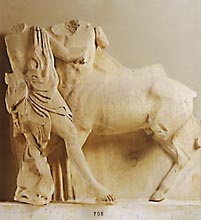 |
Only ten of the metope-panels on the north front survive. Their subject is the Fall of Troy. Since there are no scenes of violence, scholars have conjectured that these pictures were analogues of a painting by Polygnotus on the same subject (it was at the Lesche of the Cnidians, at Delphi). At its west end, gods (probably including Athena) can be seen discussing the fate of mortals. The cenrtal subject is framed by the chariot of the Sun and a female rider (either the Moon or Night).
The metope-panels on the west front have all survived but have been savagely truncated. They are regarded by nearly all scholars as showing a battle with the Amazons. On a different view, it is a battle between Greeks and Persians, but this does not square with the other subjects, which are all from mythology. Besides, the nub of all these mythological battle subjects - both the battles with Centaurs, Amazons, or Giants, and the Sack of Troy - is symbolic: Hellenes triumph over barbarians in general and Persians in particular. Moreover, battle with Centaurs and battle with Amazons are an item in the labours of Athens' national hero - Theseus. |





